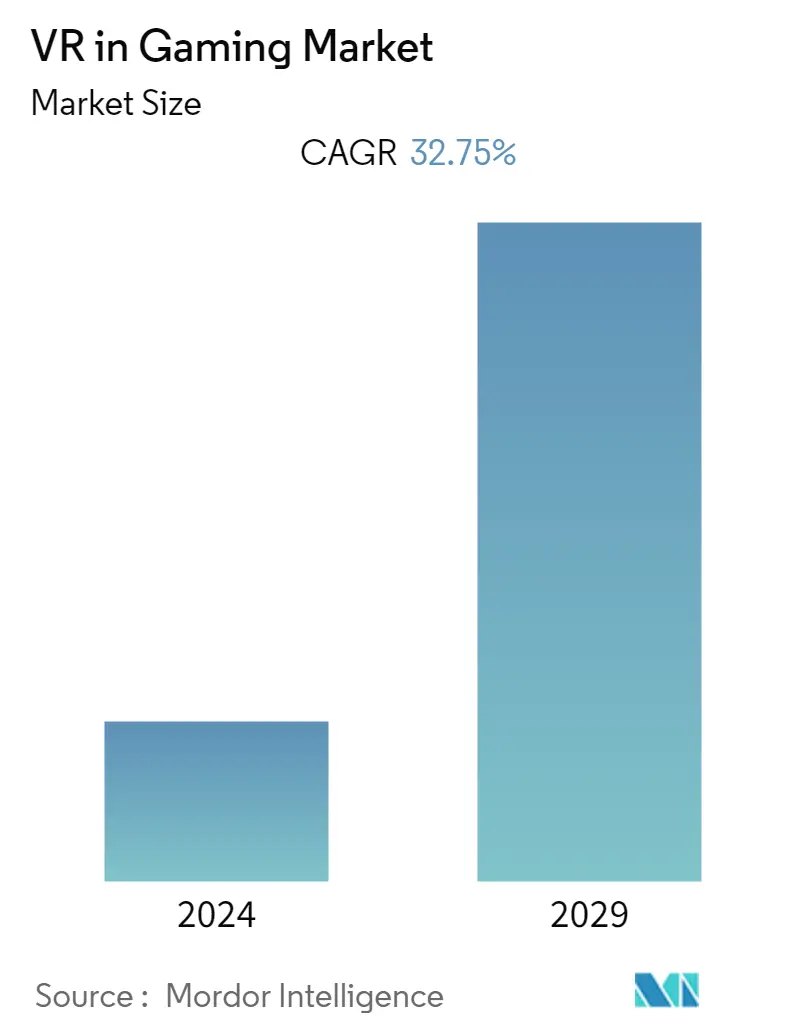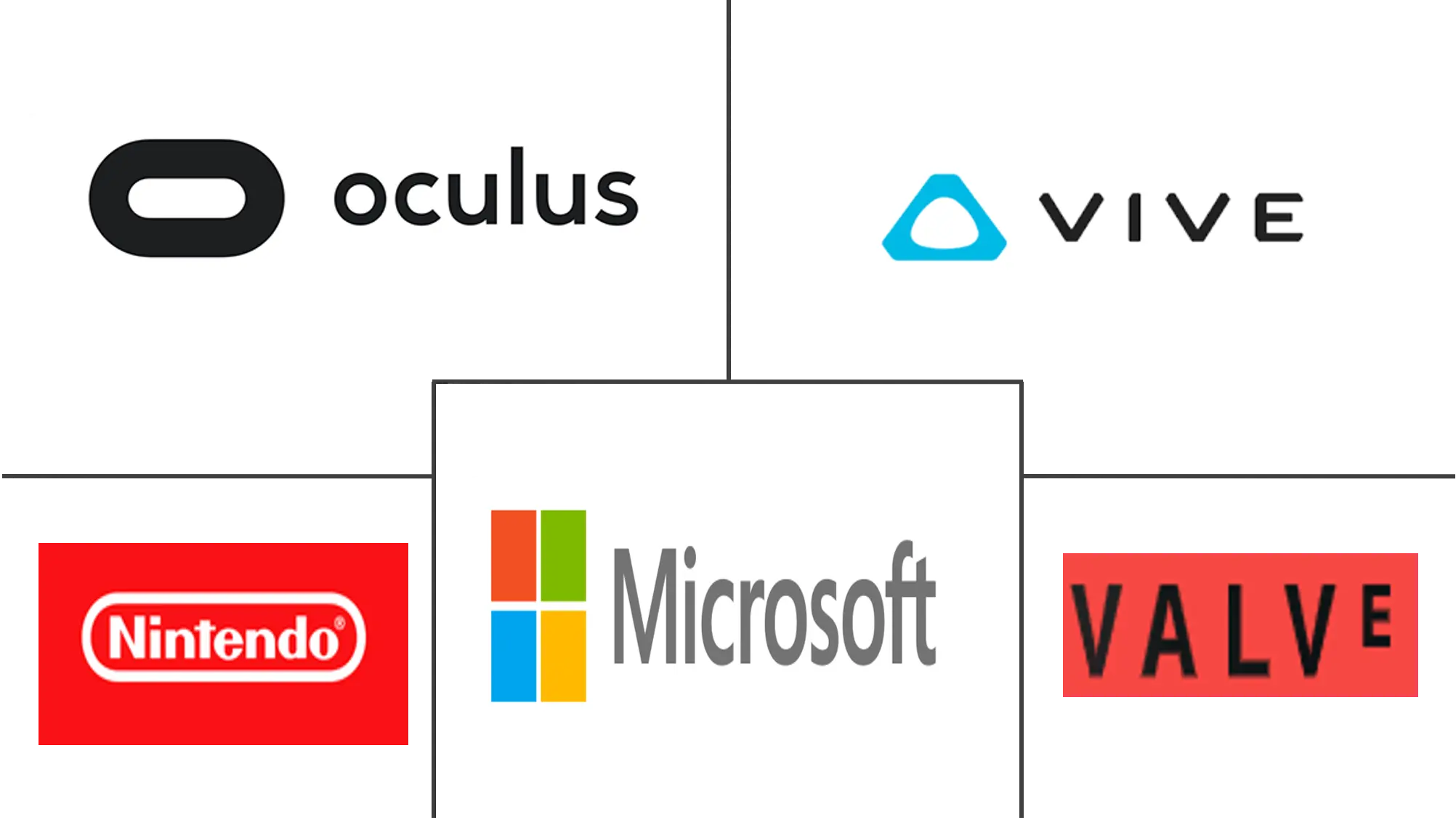Market Size of VR in Gaming Industry

| Study Period | 2019 - 2029 |
| Base Year For Estimation | 2023 |
| CAGR | 32.75 % |
| Fastest Growing Market | Asia Pacific |
| Largest Market | North America |
| Market Concentration | High |
Major Players
*Disclaimer: Major Players sorted in no particular order |
Virtual Reality in Gaming Market Analysis
Virtual reality (VR) in the gaming market is expected to witness a CAGR of 32.75% over the forecast period. VR technology has gained widespread recognition and adoption over the past few years. Recent technological advancements in this field have revealed new enterprises. Numerous players are emerging in this market, hoping to navigate it toward mainstream adoption in the gaming market space. According to NewGenApps, by 2025, the worldwide user base of AR and VR games is expected to increase to 216 million users.
VR gaming involves a 3D environment that enables the user on a computing device, with the help of a mouse, touch screen, and other components, to feel the physical presence in the game settings. The various accessories associated with VR technology, such as virtual reality headsets, wrap-around display screens, virtual reality rooms equipped with wearable computers, and sensory components, enable gamers to interact, view and move around the objects in the game setting. According to a worldwide survey of technology company executives, startup founders, investors, and consultants, 59% of respondents believe gaming will dominate the investment in VR technology development.
Moreover, VR gaming provides interaction and communication to gamers in the game environment, attracting more children's and gamers, thus driving the market's growth. According to 3Dinsider, more than 64% of active VR users believe that gaming has the highest potential to benefit from advances in VR technology.
The market is creating various jobs related to VR gaming, such as game designers, producers, programmers, artists, business, sales, and marketing roles.
VR headset is gaining traction across the market due to their specific application for games, such as HTC Vive and PlayStation VR. Also, in November last year, Sony Interactive Entertainment announced that PlayStation VR2, a new virtual reality (VR) system for the PlayStation 5 platform, would be released.
With the outbreak of COVID-19, the market for VR gaming witnessed a significant increase in adoption as most countries enforced lockdowns, and people were spending their time on VR gaming during the lockdown.
Many VR gaming providers, such as HTC Viveport, provide games with multiple features. For instance, Viveport Infinity's annual subscription had a 75% off, taking it down from USD 107.88 per year to USD 27.
In October last year, Meta confirmed the launch of a new VR headset. This product would have new capabilities enabled by eye tracking and face tracking, like the capacity to make 'eye contact in virtual reality.'
Virtual Reality in Gaming Industry Segmentation
The study analyzes the demand for VR in the gaming industry based on historical trends and current scenarios. As VR is expected to find traction among gaming enthusiasts, the study analyzes the key growth influencers and the demand from other forms of extended reality-based technologies (AR and MR). The key segments covered in the study include hardware type and geography.
Virtual Reality in the Gaming Market is segmented by Virtual Reality Type (PC, Stand-alone, Console, and Premium Mobile), Virtual Reality in Gaming (Hardware and Software), and Geography. The market sizes and forecasts are provided in terms of value (USD million) for all the above segments.
| By VR Type | |
| PC | |
| Stand-alone | |
| Console | |
| Cartridges | |
| Premium Mobile |
| By VR in Gaming | |
| Hardware | |
| Software |
| Geography | |
| North America | |
| Europe | |
| Asia-Pacific | |
| Rest of The World |
VR in Gaming Market Size Summary
The virtual reality gaming market is experiencing rapid growth, driven by technological advancements and increasing adoption of VR technology. This market is characterized by the development of immersive 3D environments that allow users to engage with game settings through various devices and accessories, such as VR headsets and sensory components. The market is witnessing a surge in interest from both consumers and investors, with a significant portion of the investment directed towards gaming applications of VR technology. The COVID-19 pandemic further accelerated the adoption of VR gaming as people sought new forms of entertainment during lockdowns. The market is also creating numerous job opportunities across various roles, including game design, programming, and marketing, as companies strive to innovate and expand their offerings.
The mobile VR gaming segment is gaining traction due to its affordability and the widespread availability of smartphones, making it accessible to a broader audience. The integration of 5G technology is expected to enhance the mobile VR experience, driving further adoption. The Asia-Pacific region, particularly China and India, is anticipated to hold a significant share of the market, supported by favorable government policies and technological advancements. The market is consolidated, with major players like Oculus VR, HTC Vive, and Microsoft Corporation leading the charge through product innovation and strategic partnerships. These companies are continuously working to enhance the VR gaming experience, ensuring the market remains competitive and dynamic.
VR in Gaming Market Size - Table of Contents
-
1. MARKET DYNAMICS
-
1.1 Market Overview
-
1.2 Market Drivers
-
1.2.1 Increasing Availability of Compelling and Theme-based Games in the VR Format
-
1.2.2 Millennial and High-income Groups to Drive Adoption in the Near and Medium-term
-
1.2.3 Premium Mobile Platform Contributing to the Growth of Market
-
-
1.3 Market Restraints
-
1.3.1 Threshold Related to Visual and Auditory Aspects | High Demand for Mobile AR Gaming
-
-
1.4 Porter's Five Forces Analysis
-
1.4.1 Threat of New Entrants
-
1.4.2 Bargaining Power of Buyers/Consumers
-
1.4.3 Bargaining Power of Suppliers
-
1.4.4 Threat of Substitute Products
-
1.4.5 Intensity of Competitive Rivalry
-
-
1.5 Impact of COVID-19 on the VR Gaming industry
-
1.6 Analysis on the Popular Themes in VR Gaming and Top Publishers (Arcade, Adventure, Horror, etc.)
-
1.7 Comparative Study of AR and VR-based Gaming
-
-
2. MARKET SEGMENTATION
-
2.1 By VR Type
-
2.1.1 PC
-
2.1.2 Stand-alone
-
2.1.3 Console
-
2.1.4 Cartridges
-
2.1.5 Premium Mobile
-
-
2.2 By VR in Gaming
-
2.2.1 Hardware
-
2.2.2 Software
-
-
2.3 Geography
-
2.3.1 North America
-
2.3.2 Europe
-
2.3.3 Asia-Pacific
-
2.3.4 Rest of The World
-
-
VR in Gaming Market Size FAQs
What is the current VR in Gaming Market size?
The VR in Gaming Market is projected to register a CAGR of 32.75% during the forecast period (2024-2029)
Who are the key players in VR in Gaming Market?
Oculus VR (Facebook Technologies LLC), HTC Vive, Nintendo Co Limited, Microsoft Corporation and Valve Corporation are the major companies operating in the VR in Gaming Market.

